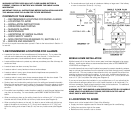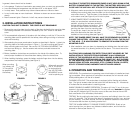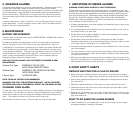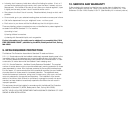
5. NUISANCE ALARMS
Smoke alarms are designed to minimize nuisance alarms. Cigarette smoke will not
normally set off the alarm, unless the smoke is blown directly into the alarm.
Combustion particles from cooking may set off the alarm if the alarm is located close
to the cooking area. Large quantities of combustible particles are generated from
spills or when broiling. Using the fan on a range hood which vents to the outside
(non-recirculating type) will also help remove these combustible products from the
kitchen.
If the alarm does sound, check for fires first. If a fire is discovered, get out and call
the fire department. If no fire is present, check to see if one of the reasons listed in
Section 2 may have caused the alarm.
6.MAINTENANCE
BATTERY REPLACEMENT
If tamper resist pin has been used, refer to TAMPER RESIST LOCKING PIN in Section
3 for removal instructions.
To replace the battery, remove the alarm from the mounting plate by rotating the
alarm in the direction of the “OFF” arrow on the cover (see Section 3, Figure 1).
The Model PE9 Smoke Alarm is powered by a 9V carbon zinc battery (alkaline and
lithium batteries may also be used). A fresh battery should last for one year under
normal operating conditions. This alarm has a low battery monitor circuit which will
cause the alarm to “chirp” approximately every 30 - 40 seconds for a minimum of
seven (7) days, accompanied by the red LED flash, when the battery gets low.
Replace the battery when this condition occurs.
USE ONLY THE FOLLOWING 9 VOLT BATTERIES FOR SMOKE ALARM
REPLACEMENT.
Carbon Zinc Type: EVEREADY 216 OR 1222;
GOLD PEAK 1604P OR 1604S
Alkaline Type: EVEREADY 522; DURACELL MN1604
GOLD PEAK 1604A
Lithium Type: ULTRALIFE U9VL
NOTE: REGULAR TESTING IS RECOMMENDED.
WARNING!! USE ONLY THE BATTERIES SPECIFIED. USE OF DIFFERENT
BATTERIES MAY HAVE A DETRIMENTAL EFFECT ON THE SMOKE ALARM.
CLEANING YOUR ALARM
To clean your alarm, remove it from the mounting bracket as outlined in the beginning
of this section. You can clean your alarm by using compressed air or your vacuum
cleaner hose to blow or suck air through the openings around the perimeter of the
alarm. The outside of the alarm can be wiped with a damp cloth.
After cleaning, reinstall your alarm. Test your alarm by using the test button.
7. LIMITATIONS OF SMOKE ALARMS
WARNING: PLEASE READ CAREFULLY AND THOROUGHLY
Smoke alarms are devices that can provide early warning of possible fires at a rea-
sonable cost; however, alarms have sensing limitations. Ionization type alarms offer a
broad range of fire sensing capabilities but are better at detecting fast flaming fires
than slow smoldering fires. Photoelectric alarms sense smoldering fires better than
flaming fires. Home fires develop in different ways and are often unpredictable.
Neither type of alarm (photoelectric or ionization) is always best, and a given alarm
may not always provide warning of a fire.
•A battery powered alarm must have a battery of the specified type, in good condi-
tion and installed properly.
•A.C. powered alarms will not operate if the A.C. power has been cut off, such as
by an electrical fire or an open fuse.
•Smoke alarms must be tested regularly to make sure the batteries and the alarm
circuits are in good operating condition.
•Smoke alarms cannot provide an alarm if smoke does not reach the alarm.
Therefore, smoke alarms may not sense fires starting in chimneys, walls, on roofs,
on the other side of a closed door or on a different floor.
• If the alarm is located outside the bedroom or on a different floor, it may not wake
up a sound sleeper.
• The use of alcohol or drugs may also impair one’s ability to hear the smoke alarm.
For maximum protection, a smoke alarm should be installed in each sleeping area
on every level of a home.
•Although smoke alarms can help save lives by providing an early warning of a fire,
they are not a substitute for an insurance policy. Home owners and renters should
have adequate insurance to protect their lives and property.
8.GOOD SAFETY HABITS
DEVELOP AND PRACTICE A PLAN OF ESCAPE
•Make a floor plan indicating all doors and windows and at least two (2) escape
routes from each room. Second story windows may need a rope or chain ladder.
•Have a family meeting and discuss your escape plan, showing everyone what to
do in case of fire.
• Determine a place outside your home where you all can meet if a fire occurs.
• Familiarize everyone with the sound of the smoke alarm and train them to leave
your home when they hear it.
•Practice a fire drill at least every six months. Practice allows you to test your plan
before an emergency. You may not be able to reach your children. It is important
they know what to do.
WHAT TO DO WHEN THE ALARM SOUNDS
• Leave immediately by your escape plan. Every second counts, so don’t waste
time getting dressed or picking up valuables.








